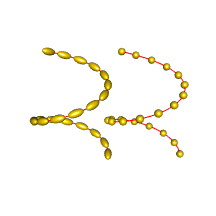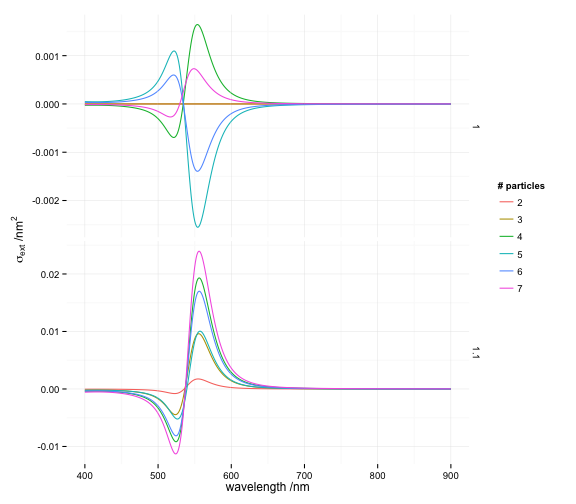-
Notifications
You must be signed in to change notification settings - Fork 4
helix_cd
baptiste edited this page Jun 22, 2014
·
7 revisions
baptiste Auguié -- 22 June, 2014
A helix of more than 4 spheres is chiral, and displays optical activity. In contrast, even a small departure from sphericity allows clusters of only 2 ellipsoids to be (strongly) optically active. We compare both situations in this demo.
# dielectric function
wvl <- seq(400, 900)
gold <- epsAu(wvl)
# define a helix
cl1 <- cluster_helix(N=20, R0=500, pitch=1000,
delta=pi/7, delta0=0, right=TRUE,
a=100, b=50, c=50,
angles='helix')
cl2 <- cluster_helix(N=20, R0=500, pitch=1000,
delta=pi/7, delta0=0, right=TRUE,
a=50, b=50, c=50,
angles="helix")
hel <- helix(N = 20, R0 = 500, pitch = 1000, delta = pi/7,
delta0 = 0, right = TRUE)
# visualise
rgl.ellipsoids(cl1$r, cl1$sizes, cl1$angles, col="gold")
lines3d(hel$smooth, lwd=1, col="red")
shifts <- cbind(rep(1000, nrow(hel$smooth)),0,0)
rgl.ellipsoids(cl2$r+shift, cl2$sizes, cl2$angles, col="gold")
lines3d(hel$smooth + shifts, lwd=1, col="red")
simulation <- function(N=3, ar=1, ...){
cl <- cluster_helix(N, R0=12, pitch=15,
delta=pi/2, delta0=0, right=TRUE,
a=5, b=5/ar, c=5/ar,
angles="helix")
circular_dichroism_spectrum(cl, material = gold, medium=1.33)
}
params <- expand.grid(N=seq(2, 7), ar= c(1, 1.1))
comparison <- mdply(params, simulation)
p <-
ggplot(data=subset(comparison, type == "CD" & variable == "extinction")) +
facet_grid(ar ~ ., scales="free") +
geom_line(aes(wavelength, value/N,
colour=factor(N))) +
labs(y=expression(sigma[ext]*" /"*nm^2),
x=expression(wavelength*" /"*nm), colour="# particles")
p